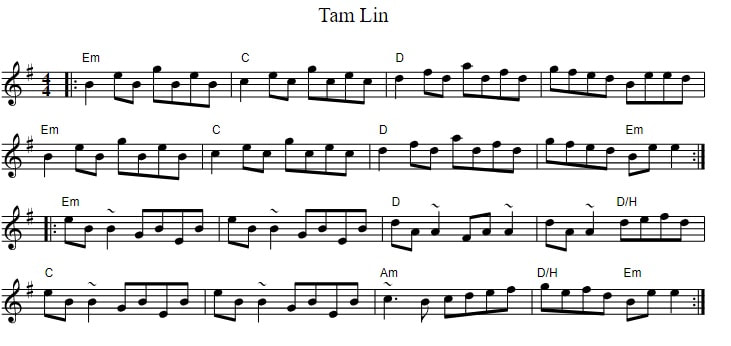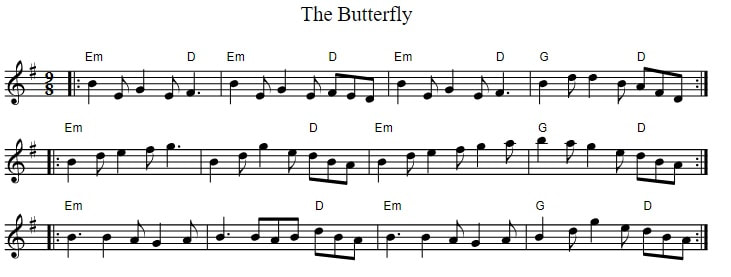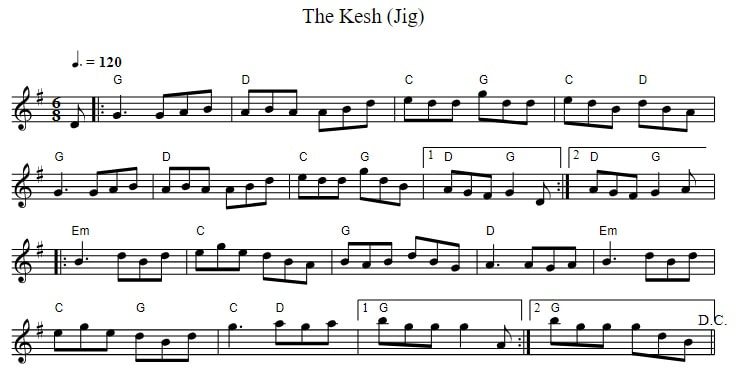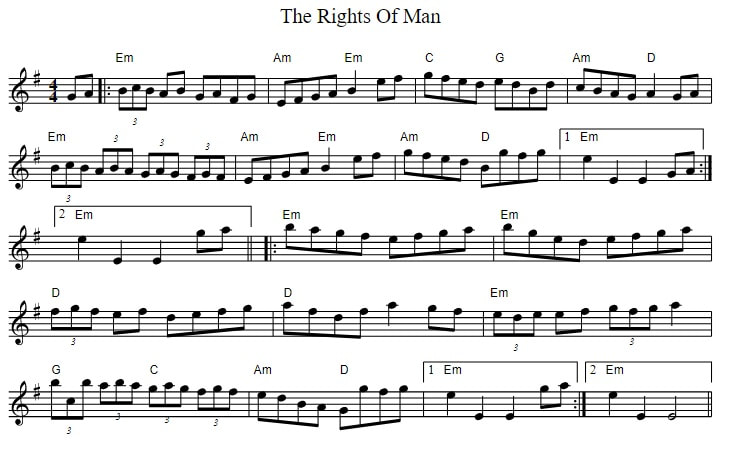Top 20 Fiddle Tunes With Chords
The Top 20 Fiddle Tunes / Songs Sheet Music With accompanying guitar chords in the keys of D and G Major. Most of these tunes are traditional Irish with a few more from Britain and the United States. The reason I threw a few songs into the mix is to keep it like a real session, where you'll always get songs mixed into traditional music to stop people getting bored. Unless you're playing to a whole audience of purists then you're going to get members of your audience loosing interest . So always do a good mix of songs with tunes. As well as the fiddle, all the tunes can be played on a tin whistle, except ''Whiskey Before Breakfast''. All of the guitar chords are fairly easy to play along with.
The PDF File above has over 100 pieces of mostly traditional Irish sheet music with guitar chords
| traditional-irish-sheet-music-with-chords.pdf |
Beginners Fiddle Sheet Music Tabs Ebook
Below is a list of songs and some tunes that are in the beginners fiddle ebook. The Tabs Show Which finger to use [ GDAE = Strings ]
1 = index finger, 2 = middle finger, etc] An example is shown below of Annie's Song.
The songbook cost €7.00 and you'll get the link after payment. You can contact me here .
1 = index finger, 2 = middle finger, etc] An example is shown below of Annie's Song.
The songbook cost €7.00 and you'll get the link after payment. You can contact me here .
Si beag si mor fiddle tab for beginners showing finger position
Beadh aonach amarach fiddle sheet music for beginners with finger positioning
the drops of brandy
The fiddle has long been a staple instrument in Irish music, playing a central role in the traditional, folk, and contemporary styles of this rich and diverse musical culture. Its distinct sound and expressive capabilities make it an integral part of the Irish musical landscape, and its history and evolution are deeply intertwined with the development of this unique musical tradition.
The origins of the fiddle can be traced back to the 9th century, when the Vikings introduced a bowed instrument to Ireland known as the “crwth”. Over time, this instrument evolved into the modern-day fiddle, and it became a popular instrument among the Irish people. With its portable size and versatility, the fiddle quickly gained popularity as a solo instrument and as part of ensembles in both rural and urban settings. In the 19th and early 20th centuries, the fiddle was a common fixture at social gatherings, house dances, and other community events, solidifying its place as a beloved instrument in Irish music.
The fiddle’s role in Irish music goes beyond just being a melodic instrument. It also serves as a rhythmic instrument, with its percussive bowing techniques adding a driving pulse to the music. This is particularly evident in Irish dance music, where the fiddle often takes on the role of the lead instrument, setting the pace and providing the melodic framework for dancers. In addition to its rhythmic capabilities, the fiddle is also highly adaptable, able to play both slow, mournful airs and fast, lively jigs and reels. This versatility allows it to be seamlessly integrated into various styles of Irish music, from the more traditional sean-nós singing to the lively and energetic céilí dances.
One of the unique aspects of playing the fiddle in Irish music is the emphasis on ornamentation. These intricate and often improvised embellishments add a layer of complexity and virtuosity to the music, making it a challenging instrument to master. This style of playing requires not only technical proficiency but also a deep understanding of the traditional repertoire and the ability to improvise and add one’s own personal touch to the music. As such, learning to play the fiddle in the Irish tradition is not just about mastering the instrument, but also about immersing oneself in the culture and history of the music.
The fiddle has also played a significant role in preserving and promoting Irish music traditions. During the 19th century, as Ireland faced social and political upheavals, many Irish people emigrated to other countries, taking their music with them. The fiddle was a popular instrument among these emigrants, and it became a symbol of their cultural identity and a way to connect with their homeland. This led to the spread of Irish music throughout the world, and the fiddle became an essential instrument in Irish music communities around the globe.
Today, the fiddle continues to be a vital part of Irish music, both in its traditional form and in its fusion with other musical genres. It has been embraced by contemporary Irish musicians, who have pushed the boundaries of traditional music and incorporated elements from other genres, such as rock and jazz, into their playing. This has led to a revitalization of Irish music and a renewed interest in the fiddle as an instrument.
In conclusion, the fiddle has played a crucial role in the development and evolution of Irish music. Its unique sound, versatility, and adaptability have made it an integral part of this vibrant musical tradition. From its humble beginnings as a Viking instrument to its current status as a symbol of Irish culture, the fiddle continues to capture the hearts and minds of musicians and audiences alike. Its legacy will undoubtedly continue to shape and influence Irish music for generations to come.
The origins of the fiddle can be traced back to the 9th century, when the Vikings introduced a bowed instrument to Ireland known as the “crwth”. Over time, this instrument evolved into the modern-day fiddle, and it became a popular instrument among the Irish people. With its portable size and versatility, the fiddle quickly gained popularity as a solo instrument and as part of ensembles in both rural and urban settings. In the 19th and early 20th centuries, the fiddle was a common fixture at social gatherings, house dances, and other community events, solidifying its place as a beloved instrument in Irish music.
The fiddle’s role in Irish music goes beyond just being a melodic instrument. It also serves as a rhythmic instrument, with its percussive bowing techniques adding a driving pulse to the music. This is particularly evident in Irish dance music, where the fiddle often takes on the role of the lead instrument, setting the pace and providing the melodic framework for dancers. In addition to its rhythmic capabilities, the fiddle is also highly adaptable, able to play both slow, mournful airs and fast, lively jigs and reels. This versatility allows it to be seamlessly integrated into various styles of Irish music, from the more traditional sean-nós singing to the lively and energetic céilí dances.
One of the unique aspects of playing the fiddle in Irish music is the emphasis on ornamentation. These intricate and often improvised embellishments add a layer of complexity and virtuosity to the music, making it a challenging instrument to master. This style of playing requires not only technical proficiency but also a deep understanding of the traditional repertoire and the ability to improvise and add one’s own personal touch to the music. As such, learning to play the fiddle in the Irish tradition is not just about mastering the instrument, but also about immersing oneself in the culture and history of the music.
The fiddle has also played a significant role in preserving and promoting Irish music traditions. During the 19th century, as Ireland faced social and political upheavals, many Irish people emigrated to other countries, taking their music with them. The fiddle was a popular instrument among these emigrants, and it became a symbol of their cultural identity and a way to connect with their homeland. This led to the spread of Irish music throughout the world, and the fiddle became an essential instrument in Irish music communities around the globe.
Today, the fiddle continues to be a vital part of Irish music, both in its traditional form and in its fusion with other musical genres. It has been embraced by contemporary Irish musicians, who have pushed the boundaries of traditional music and incorporated elements from other genres, such as rock and jazz, into their playing. This has led to a revitalization of Irish music and a renewed interest in the fiddle as an instrument.
In conclusion, the fiddle has played a crucial role in the development and evolution of Irish music. Its unique sound, versatility, and adaptability have made it an integral part of this vibrant musical tradition. From its humble beginnings as a Viking instrument to its current status as a symbol of Irish culture, the fiddle continues to capture the hearts and minds of musicians and audiences alike. Its legacy will undoubtedly continue to shape and influence Irish music for generations to come.

























